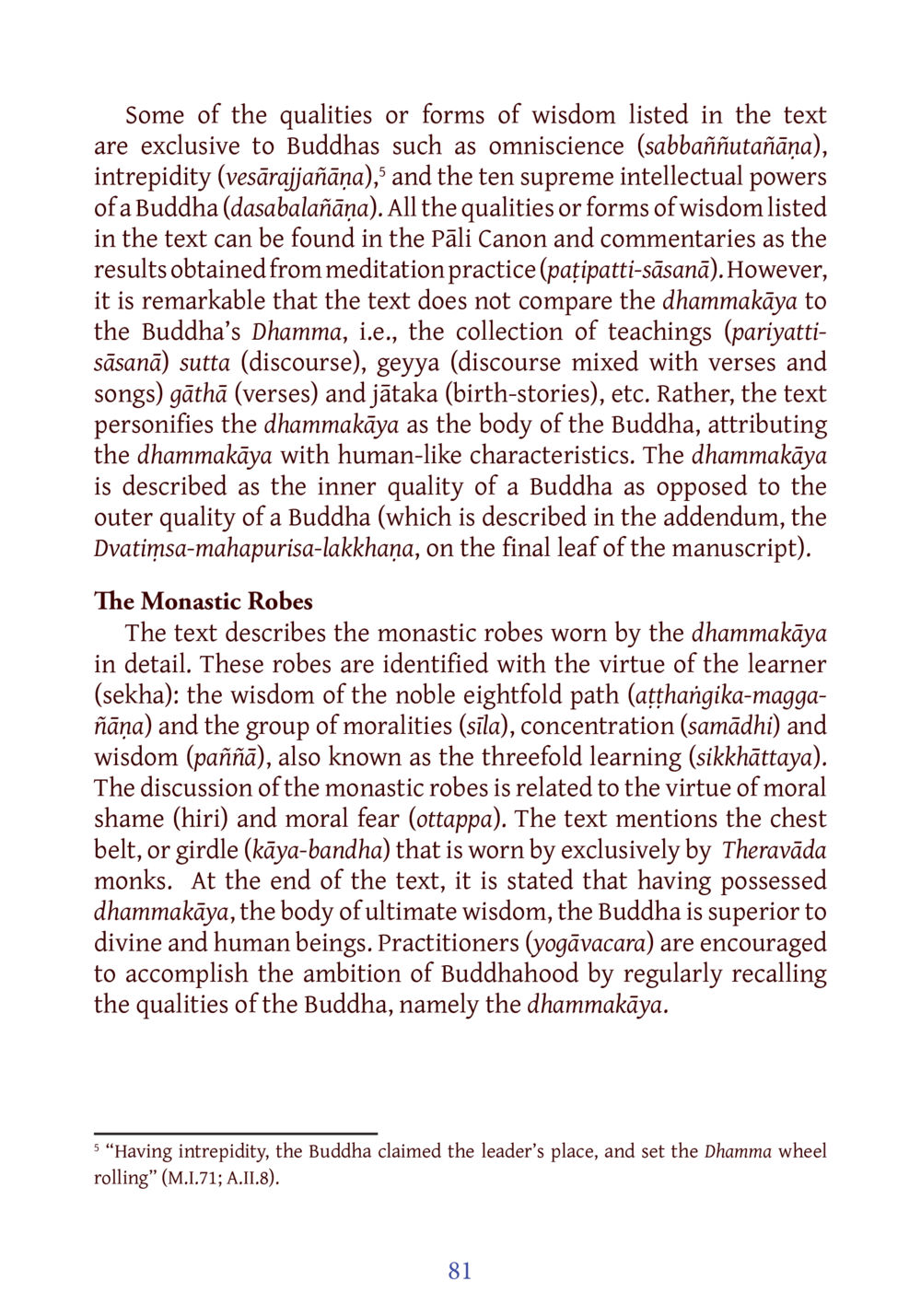Wisdom and the Dhammakāya in Buddhist Teachings : หน้า 102/141
DIRI Journal : หน้า 102/141 Explore the qualities of wisdom unique to Buddhas and the significance of dhammakāya in Buddhist philosophy, including monastic robes and moral virtues.
4 ครั้ง

สรุปเนื้อหา
The text highlights unique qualities of wisdom exclusive to Buddhas, including omniscience and the ten intellectual powers. It discusses the dhammakāya as the embodiment of a Buddha's inner wisdom, distinct from outer teachings. The detailed description of monastic robes relates to moral virtues and the noble eightfold path, emphasizing the importance of these elements in attaining Buddhahood. The dhammakāya symbolizes ultimate wisdom, positioning the Buddha above all beings. Practitioners are urged to remember these qualities to inspire their journey towards enlightenment. More information can be found at dmc.tv.
หัวข้อประเด็น
-Buddha's wisdom
-dhammakāya
-monastic robes
-moral virtues
-noble eightfold path
-meditation practices
-Buddhahood aspirations
ข้อความต้นฉบับในหน้า
Some of the qualities or forms of wisdom listed in the text are exclusive to Buddhas such as omniscience (sabbaññutāna), intrepdity (vesārajjanāna), and the ten supreme intellectual powers of a Buddha (dasabalaññaṇa). All the qualities or forms of wisdom listed in the text can be found in the Pāli Canon and commentaries as the results obtained from meditation practice (paṭipatti-sāsanā). However, it is remarkable that the text does not compare the dhammakāya to the Buddha’s Dhamma, i.e., the collection of teachings (pariyatti-sāsanā) sutta (discourse), geyya (discourse mixed with verses and songs) gāthā (verses) and jātaka (birth-stories), etc. Rather, the text personifies the dhammakāya as the body of the Buddha, attributing the dhammakāya with human-like characteristics. The dhammakāya is described as the inner quality of a Buddha as opposed to the outer quality of a Buddha (which is described in the addendum, the Dvatiṃsa-mahapurisa-lakkhaṇa, on the final leaf of the manuscript).
**The Monastic Robes**
The text describes the monastic robes worn by the dhammakāya in detail. These robes are identified with the virtue of the learner (sekha): the wisdom of the noble eightfold path (atthaṅgika-magga-ñāṇa) and the group of moralities (sīla), concentration (samādhi) and wisdom (paṇñā), also known as the threefold learning (sikhāttaya). The discussion of the monastic robes is related to the virtue of moral shame (hiri) and moral fear (ottappa). The text mentions the chest belt, or girdle (kāya-bandha) that is worn by exclusively by Theravāda monks. At the end of the text, it is stated that having possessed dhammakāya, the body of ultimate wisdom, the Buddha is superior to divine and human beings. Practitioners (yogāvacara) are encouraged to accomplish the ambition of Buddhahood by regularly recalling the qualities of the Buddha, namely the dhammakāya.
5 “Having intrepidity, the Buddha claimed the leader’s place, and set the Dhamma wheel rolling” (M.I.71; A.II.8).
หน้าหนังสือทั้งหมด

1

2

3

4

5

6

7

8

9

10

11

12

13

14

15

16

17

18

19

20

21

22

23

24

25

26

27

28

29

30

31

32

33

34

35

36

37

38

39

40

41

42

43

44

45

46

47

48

49

50

51

52

53

54

55

56

57

58

59

60

61

62

63

64

65

66

67

68

69

70

71

72

73

74

75

76

77

78

79

80

81

82

83

84

85

86

87

88

89

90

91

92

93

94

95

96

97

98

99

100

101

102

103

104

105

106

107

108

109

110

111

112

113

114

115

116

117

118

119

120

121

122

123

124

125

126

127

128

129

130

131

132

133

134

135

136

137

138

139

140

141
หนังสือที่เกี่ยวข้อง
Load More
